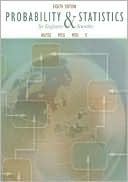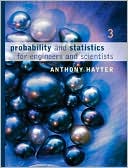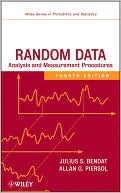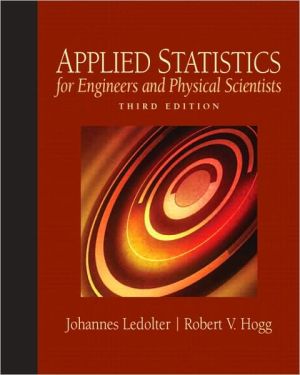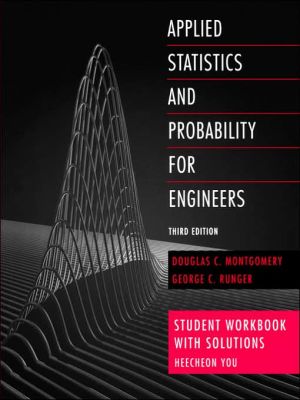Miller & Freund's Probability and Statistics for Engineers
This text is rich in exercises and examples, and explores both elementary probability and basic statistics, with an emphasis on engineering and science applications. Much of the data have been collected from the author's own consulting experience and from discussions with scientists and engineers about the use of statistics in their fields. In later chapters, the book emphasizes designed experiments, especially two-level factorial design.
Search in google:
This text is rich in exercises and examples, and explores both elementary probability and basic statistics, with an emphasis on engineering and science applications. Much of the data have been collected from the author's own consulting experience and from discussions with scientists and engineers about the use of statistics in their fields. In later chapters, the book emphasizes designed experiments, especially two-level factorial design.
Preface1. Introduction1.1 Why Study Statistics?1.2 Modern Statistics1.3 Statistics and Engineering1.4 The Role of the Scientist and Engineer in Quality Improvement1.5 A Case Study: Visually Inspecting Data to Improve Product Quality1.6 Two Basic Concepts–Population and Sample2. Organization and Description of Data2.1 Pareto Diagrams and Dot Diagrams2.2 Frequency Distributions2.3 Graphs of Frequency Distributions2.4 Stem-and-Leaf Displays2.5 Descriptive Measures2.6 Quartiles and Percentiles2.7 The Calculation of x and s2.8 A Case Study: Problems with Aggregating Data3. Probability3.1 Sample Spaces and Events3.2 Counting3.3 Probability3.4 The Axioms of Probability3.5 Some Elementary Theorems3.6 Conditional Probability3.7 Bayes’ Theorem4. Probability Distributions4.1 Random Variables4.2 The Binomial Distribution4.3 The Hypergeometric Distribution4.4 The Mean and the Variance of a Probability Distribution4.5 Chebyshev’s Theorem4.6 The Poisson Approximation to the Binomial Distribution4.7 Poisson Processes4.8 The Geometric and Negative Binomial Distribution4.9 The Multinomial Distribution4.10 Simulation5. Probability Densities5.1 Continuous Random Variables5.2 The Normal Distribution5.3 The Normal Approximation to the Binomial Distribution5.4 Other Probability Densities5.5 The Uniform Distribution5.6 The Log-Normal Distribution5.7 The Gamma Distribution5.8 The Beta Distribution5.9 The Weibull Distribution5.10 Joint Distributions–Discrete and Continuous5.11 Moment Generating Functions5.12 Checking If the Data Are Normal5.13 Transforming Observations to Near Normality5.14 Simulation6. Sampling Distributions6.1 Populations and Samples6.2 The Sampling Distribution of the Mean (σ known)6.3 The Sampling Distribution of the Mean (σ unknown)6.4 The Sampling Distribution of the Variance6.5 Representations of the Normal Theory Distributions6.6 The Moment Generating Function Method to Obtain Distributions6.7 Transformation Methods to Obtain Distributions7. Inferences Concerning a Mean7.1 Point Estimation7.2 Interval Estimation7.3 Maximum Likelihood Estimation7.4 Tests of Hypotheses7.5 Null Hypotheses and Tests of Hypotheses7.6 Hypotheses Concerning One Mean7.7 The Relation between Tests and Confidence Intervals7.8 Power, Sample Size, and Operating Characteristic Curves8. Comparing Two Treatments8.1 Experimental Designs for Comparing Two Treatments8.2 Comparisons–Two Independent Large Samples8.3 Comparisons–Two Independent Small Samples8.4 Matched Pairs Comparisons8.5 Design Issues–Randomization and Pairing9. Inferences Concerning Variances9.1 The Estimation of Variances9.2 Hypotheses Concerning One Variance9.3 Hypotheses Concerning Two Variances10. Inferences Concerning Proportions10.1 Estimation of Proportions10.2 Hypotheses Concerning One Proportion10.3 Hypotheses Concerning Several Proportions10.4 Analysis of r x c Tables10.5 Goodness of Fit11. Regression Analysis11.1 The Method of Least Squares11.2 Inferences Based on the Least Squares Estimators11.3 Curvilinear Regression11.4 Multiple Regression11.5 Checking the Adequacy of the Model11.6 Correlation11.7 Multiple Linear Regression (Matrix Notation)12. Analysis of Variance12.1 Some General Principles12.2 Completely Randomized Designs12.3 Randomized-Block Designs12.4 Multiple Comparisons12.5 Analysis of Covariance13. Factorial Experimentation13.1 Two-Factor Experiments13.2 Multifactor Experiments13.3 2n Factorial Experiments13.4 The Graphic Presentation of 22 and 23 Experiments13.5 Response Surface Analysis13.6 Confounding in a 2n Factorial Experiment13.7 Fractional Replication14. Nonparametric Tests14.1 Introduction14.2 The Sign Test14.3 Rank-Sum Tests14.4 Correlation Based on Ranks14.5 Tests of Randomness14.6 The Kolmogorov-Smirnov and Anderson-Darling Tests15. The Statistical Content of Quality-Improvement Programs15.1 Quality-Improvement Programs15.2 Starting a Quality-Improvement Program15.3 Experimental Designs for Quality15.4 Quality Control15.5 Control Charts for Measurements15.6 Control Charts for Attributes15.7 Tolerance Limits16. Application to Reliability and Life Testing16.1 Reliability16.2 Failure-Time Distribution16.3 The Exponential Model in Life Testing16.4 The Weibull Model in Life TestingAppendix A BibliographyAppendix B Statistical TablesAppendix C Using the R Software ProgramAppendix D Answers to Odd-Numbered Exercises


